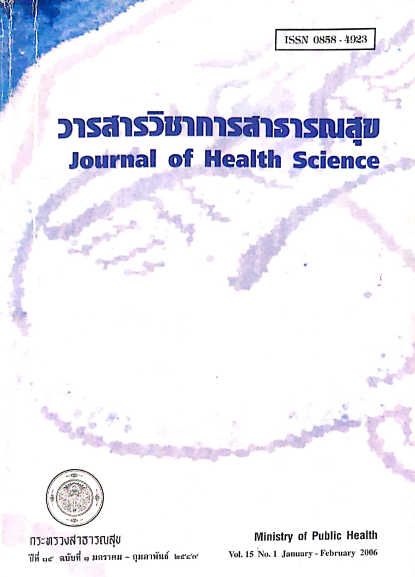Research Series of Thai Health Care Financing: Part 3: Co-Payment in Universal Coverage Scheme : A Policy Analysis - ชุดวิจัยการเงินการคลังระบบสุขภาพไทย : ตอนที่ ๓ การจ่ายร่วมในระบบหลักประกันสุขภาพถ้วนหน้า: บทวิเคราะห์เชิงนโยบาย
Abstract
บทคัดย่อ
การสร้างหลักประกันสุขภาพถ้วนหน้าเริ่มดำเนินการทั่วประเทศในเดือนตุลาคม พ.ศ. ๒๕๕๔ ได้กำหนดให้มีการจ่ายร่วมในการรักษาพยาบาลเป็นเงิน ๓๐ บาทต่อครั้ง ยกเว้นผู้ถือบัตรสวัสดิการรักษาพยาบาล สำหรับผู้ที่สังคมควรช่วยเหลือเกื้อกูล (สปร.) ผู้สูงอายุ อาสาสมัครสาธารณสุข และเด็กอายุต้ำกว่า ๑๒ ปี ซึ่งควรพิจารณาว่าอัตรานี้เหมาะสมหรือไม่ทั้งในด้านเป็นแหล่งรายได้ของสถานพยาบาล และเป็นมาตรการที่ มีประสิทธิผลในการป้องกันการใช้บริการที่เกินจำเป็นของผู้ป่วย
การศึกษานี้มีวัตถุประสงค์เพื่อประเมินสถานะทางเศรษฐกิจของผู้ถือบัตรทองทั้งประเภทที่ต้องจ่ายร่วม และได้รับการรักษาฟรี อัตราการใช้บริการรักษาพยาบาลของกลุ่มผู้ป่วยที่ได้รับบัตรทองประเภทที่ต้องจ่ายร่วม (ไม่มี ท.) และประมาณการรายได้จากการเรียกเก็บค่ารักษาครั้งละ ๓๐ บาทของผู้ที่ต้องจ่ายร่วม และเพื่อนำเสนอแนวทางเชิงนโยบายสำหรับการปฏิรูปการจ่ายร่วม โดยใช้ข้อมูลการสำรวจอนามัยและสวัสดิการ พ.ศ. ๒๕๔๖ ของสำนักงานสถิติแห่งชาติ เป็นฐานข้อมูลหลักของการวิเคราะห์ ทำการวิเคราะห์ข้อมูลเหล่านี้ใน ช่วงเดือนเมษายน ถึงพฤษภาคม พ.ศ. ๒๕๔๗
ในกลุ่มผู้ที่ได้รับการรักษาพยาบาลฟรีโดยไม่ต้องจ่ายร่วมนั้น ร้อยละ ๔ เป็นผู้ที่อยู่ในกลุ่มคนรวยที่สุด จากทั้งหมด ๔ กลุ่ม และร้อยละ ๙ เป็นผู้ที่อยู่ในกลุ่มคนรวยรองลงมา สำหรับผู้ถือบัตรทองประเภทที่ต้องมีการจ่ายร่วม ๓๐ บาทนั้น เป็นผู้ที่อยู่ในกลุ่มคนจนที่สุดถึงร้อยละ ๒๙ และเป็นผู้ที่อยู่ในกลุ่มคนจนร้อยละ ๒๕ เมื่อประมาณการรายรับจากการจ่ายร่วมพบว่าเป็นจำนวนเงินไม่มากนัก เพียง ๑,๐๗๓ ล้านบาทใน พ.ศ. ๒๕๔๖ คิดเป็นร้อยละ ๑.๙ ของงบประมาณเหมาจ่ายรายหัวทั้งหมด หากพิจารณาในด้านการเป็นมาตรการเพื่อป้องกันการมาใช้บริการที่เกินจำเป็นแล้ว เงื่อนไขนี้ไม่น่าจำเป็นสำหรับกรณีการรักษาพยาบาลของผู้ป่วยใน เนื่องจากต้องเป็นวินิจฉัยของแพทย์ในการรับเข้าเป็นผู้ป่วยใน การใช้บริการอย่างฟุ่มเฟือยกรณีผู้ป่วยในเป็นไปไม่ได้ ภายใต้การจ่ายเงินแบบเพดานงบประมาณและกลุ่มวินิจฉัยโรคร่วม (global budget and DRG payment) อย่างไรก็ดี การจ่ายร่วมอาจจะยังคงจำเป็นสำหรับกรณีผู้ป่วยนอกเนื่องจากเป็นด่านแรกของการ รักษาพยาบาล
ไม่ว่าจะปฏิรูปการจ่ายร่วมไปในรูปแบบใด สิ่งที่ต้องดำเนินการก่อนอื่นคือ การประเมินและทบทวนการออกบัตรทองทั้งประเภทมี ท. และไม่มี ท. เพื่อให้ตรงกับกลุ่มเป้าหมายมากที่สุด โดยกลุ่มที่ต้องจ่ายร่วม ไม่ควรจะมีผู้ที่อยู่ในกลุ่มที่ยากจนที่สุดอยู่เลย การจ่ายรวมไม่ใช่เครื่องมือในการสร้างแหล่งการคลังสุขภาพที่มีนัยสำคัญสำหรับการสร้างหลักประกันสุขภาพถ้วนหน้า เมื่อเทียบกับงบประมาณทั้งหมด ดังนั้นควรยกเลิกการจ่ายรวมในกรณีผู้ป่วยใน เนื่องจากบริการผู้ป่วยในไม่น่ามีปัญหาการใช้บริการเกินจำเป็นและผู้ให้บริการในระบบหลักประกันสุขภาพถ้วนหน้าก็ไม่มีสิ่งจูงใจให้ทำเช่นนั้น ท้ายที่สุด ควรยกเลิกการจ่ายร่วมในสถานพยาบาลระดับสถานีอนามัยทั้งนี้เพื่อเป็นการส่งเสริมการใช้บริการในระดับปฐมภูมิ ในขณะเดียวกัน ควรศึกษาสถานการณ์การใช้บริการที่ฟุ่มเฟือยหรือเกินจำเป็นในกลุ่มผู้มีหลักประกันสุขภาพถ้วนหน้า ถ้ามี มีมากน้อยเพียงใด ก่อนจะปรับเพิ่มอัตราการจ่ายร่วมในอนาคต
คำสำคัญ: หลักประกันสุขภาพถ้วนหน้า, การจ่ายร่วม, การใช้บริการเกินจำเป็น
Abstract
Universal Coverage Scheme was launched nation-wide by the government in October 2001. The scheme was financed by general tax revenue with literally free access to contractor primary care unit (PCU) and registered hospitals. A nominal fee (co-payment), 30 baht per visit or per admission, was introduced for UC Pay member (UCP). UC exempted (UCE) members who were the ex-members of Low Income Scheme, the elderly, children under 12 years, monks, war veterans, and village health volunteers were exempted from the co-payment. Current policy debates focused on the appropriateness of co-payment level to deter any unnecessary demand for care as well as capacity to generate some revenue to finance the scheme.
This study examined and classified income quintiles of UCE and UCP members, service utilization rate of UCP, and total revenue generate from co-payment. The study also proposed several scenarios for reform in both directions (termination and increase of co-payment). The 2003 Health and Welfare Survey (HWS) conducted by the National Statistical Office (NSO) was the data set used for the analysis. The analysis had been done during April - May 2004.
There was a substantial portion of the poorest (29%) and the poor (25%) quintiles among UCP members, and a small portion of the rich (9%) and the richest (4%) quintiles among UCE members. Estimated revenue from co pay was probably negligible. This was 1,073 million baht in FY2003 or 1.9 percent of total capitation budget financed by the government. Co-payment was advocated to deter unnecessary demand among users, but this study proposed that it might not be necessary for in-patients (IP) as admissions were clinically indicated under global budget plus DRG payment system. However, co pay might be necessary for ambulatory services as contractors were in weaker positions to contain demand.
It was recommended that any reform of co-payment should be to over-haul the issuance of UCE and UCP to better targeting as a pre-requisite. Co-payment was not a significant resource generation tool to finance UC scheme compared to capitation. Co-payment for IP should be terminated to abolish barrier to health services and prevent patients' welfare loss; there was literally no moral hazard as providers have no incentive to unnecessary admit patients. Finally, co pay should be terminated at HC level in order to advocate use of primary care. In the meantime, research to provide evidence if there was a moral hazard among UC members as well as quantifying the magnitude of moral hazard is needed, prior to major revision of this policy.
Key words: Universal Coverage, co-payment, moral hazard





